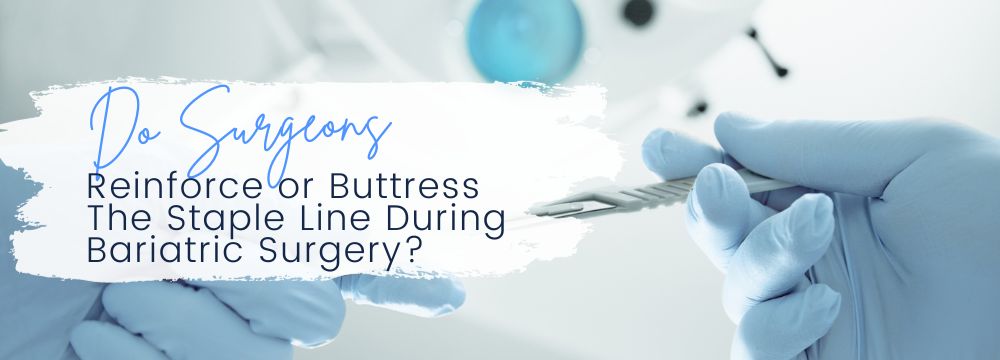Do Surgeons Reinforce or Buttress the Staple Line During Bariatric Surgery?

One of the most exciting parts of being in the bariatric field is seeing the excellent and in-depth questions bariatric patients have. Weight loss surgery patients are some of the most educated on their procedures. As such, we’re often surprised by great and often very technical questions, one of which is whether bariatric surgeons use reinforcement or buttressing on the staple line during bariatric surgery.
What Exactly Is Reinforcement or Buttressing of the Staple Line?
We need to know precisely how the staple line works to understand the question and offer a solid answer. A specially made cutting device uses disposable cartridges to assist the surgeon. When the cartridge is deployed, a blade cuts through the stomach, dividing it while three rows of staples are simultaneously deployed into the tissue, creating a tight seal on either side of the cut. This redundant staple line means there are fewer chances of a leak, which can cause significant complications, including infection, admission to the hospital, and potentially additional surgery.
In the past, buttressing or reinforcing the staple line with biological tissue or even synthetic materials has been used to, theoretically, reduce the likelihood of one of these devastating leaks.
Why Many Surgeons Don’t Reinforce the Staple Line?
Ultimately, surgical technology has improved such that most bariatric surgeons no longer use reinforcement on their staple line. The clinical data have said as much.
- Leak rates are often quoted from less than .5% to up to 3%¹‚²
- Many studies have shown no difference in leak rate between reinforced and non-reinforced staple lines.³
How Leaks Are Treated
While leaks are relatively rare, they happen, and bariatric surgeons have well-designed protocols to address them. For otherwise healthy patients, resolution of the leak may include antimicrobial therapy and a modified diet. For patients with compromised health status, a follow-up and endoscopic or surgical procedure may be necessary to correct the issue and flush out the infection. Most importantly, patients should follow the postoperative care plan closely and be on the lookout for any signs of infection, including those that may be caused by a leak.
We are always looking to answer interesting questions and encourage you to submit one of your own. Feel free to visit our Instagram or Facebook page for further questions.
References:
- Praveenraj P, Gomes RM, Kumar S, Senthilnathan P, Parthasarathi R, Rajapandian S, Palanivelu C. Management of gastric leaks after laparoscopic sleeve gastrectomy for morbid obesity: A tertiary care experience and design of a management algorithm. J Minim Access Surg. 2016 Oct-Dec;12(4):342-9. doi: 10.4103/0972-9941.181285. PMID: 27251808; PMCID: PMC5022516.
- Abou Rached A, Basile M, El Masri H. Gastric leaks post sleeve gastrectomy: review of its prevention and management. World J Gastroenterol. 2014 Oct 14;20(38):13904-10. doi: 10.3748/wjg.v20.i38.13904. PMID: 25320526; PMCID: PMC4194572.
- Knapps J, Ghanem M, Clements J, Merchant AM. A systematic review of staple-line reinforcement in laparoscopic sleeve gastrectomy. JSLS. 2013 Jul-Sep;17(3):390-9. doi: 10.4293/108680813X13654754534639. PMID: 24018075; PMCID: PMC3771757.

